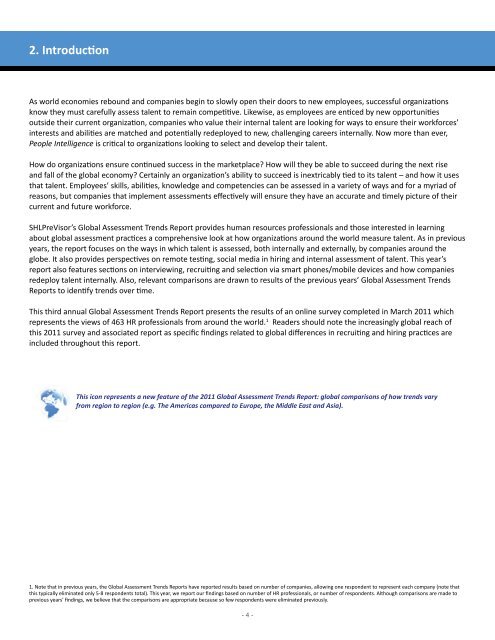Research Report
Research report
Research report
Create successful ePaper yourself
Turn your PDF publications into a flip-book with our unique Google optimized e-Paper software.
2. Introduction<br />
As world economies rebound and companies begin to slowly open their doors to new employees, successful organizations<br />
know they must carefully assess talent to remain competitive. Likewise, as employees are enticed by new opportunities<br />
outside their current organization, companies who value their internal talent are looking for ways to ensure their workforces’<br />
interests and abilities are matched and potentially redeployed to new, challenging careers internally. Now more than ever,<br />
People Intelligence is critical to organizations looking to select and develop their talent.<br />
How do organizations ensure continued success in the marketplace? How will they be able to succeed during the next rise<br />
and fall of the global economy? Certainly an organization’s ability to succeed is inextricably tied to its talent – and how it uses<br />
that talent. Employees’ skills, abilities, knowledge and competencies can be assessed in a variety of ways and for a myriad of<br />
reasons, but companies that implement assessments effectively will ensure they have an accurate and timely picture of their<br />
current and future workforce.<br />
SHLPreVisor’s Global Assessment Trends <strong>Report</strong> provides human resources professionals and those interested in learning<br />
about global assessment practices a comprehensive look at how organizations around the world measure talent. As in previous<br />
years, the report focuses on the ways in which talent is assessed, both internally and externally, by companies around the<br />
globe. It also provides perspectives on remote testing, social media in hiring and internal assessment of talent. This year’s<br />
report also features sections on interviewing, recruiting and selection via smart phones/mobile devices and how companies<br />
redeploy talent internally. Also, relevant comparisons are drawn to results of the previous years’ Global Assessment Trends<br />
<strong>Report</strong>s to identify trends over time.<br />
This third annual Global Assessment Trends <strong>Report</strong> presents the results of an online survey completed in March 2011 which<br />
represents the views of 463 HR professionals from around the world. 1 Readers should note the increasingly global reach of<br />
this 2011 survey and associated report as specific findings related to global differences in recruiting and hiring practices are<br />
included throughout this report.<br />
This icon represents a new feature of the 2011 Global Assessment Trends <strong>Report</strong>: global comparisons of how trends vary<br />
from region to region (e.g. The Americas compared to Europe, the Middle East and Asia).<br />
1. Note that in previous years, the Global Assessment Trends <strong>Report</strong>s have reported results based on number of companies, allowing one respondent to represent each company (note that<br />
this typically eliminated only 5-8 respondents total). This year, we report our findings based on number of HR professionals, or number of respondents. Although comparisons are made to<br />
previous years’ findings, we believe that the comparisons are appropriate because so few respondents were eliminated previously.<br />
- 4 -



